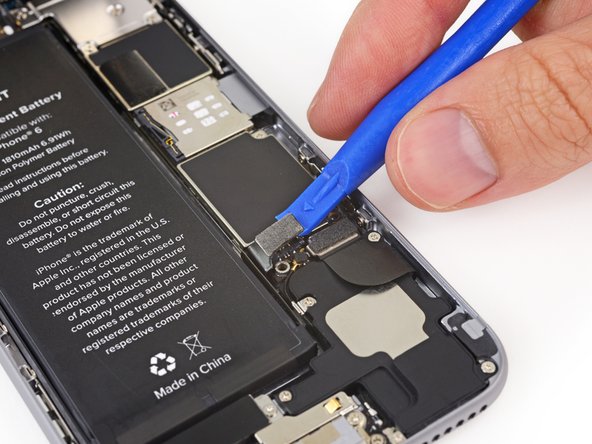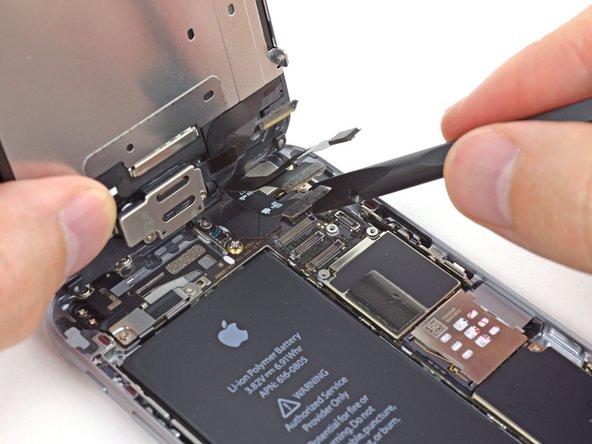How Hard Is It To Fix Iphone 6 Screen
Introduction
Learn how to replace your iPhone 6 screen. This part comes with the front-facing camera, earpiece speaker and LCD shield plate already installed, making for an easier repair.
All you need to do is remove the old screen and transfer the home button to the new screen.
You can also use this guide to replace the front panel assembly cable bracket.
Video Overview
-
-
Before disassembling your iPhone, discharge the battery below 25%. A charged lithium-ion battery can catch fire and/or explode if accidentally punctured.
-
Power off your iPhone before beginning disassembly.
-
Remove the two 3.6 mm-long P2 Pentalobe screws next to the Lightning connector.
-
-
-
If your display glass is cracked, keep further breakage contained and prevent bodily harm during your repair by taping over the glass.
-
Lay overlapping strips of clear packing tape over the iPhone's display until the whole face is covered.
-
This will keep glass shards contained and provide structural integrity when prying and lifting the display.
-
Wear safety glasses to protect your eyes from any glass shaken free during the repair.
-
If the broken glass makes it difficult to get a suction cup to stick in the next few steps, try folding a strong piece of tape (such as duct tape) into a handle and lifting the display with that instead.
-
-
-
The next three steps demonstrate using the iSclack, a great tool for safely opening the iPhone 6 that we recommend for anyone doing more than one repair. If you aren't using the iSclack, skip down three steps for an alternate method.
-
If the plastic depth gauge is attached at the center of the iSclack, remove it now—it's not needed for larger phones like the iPhone 6.
-
Close the handle on the iSclack, opening the suction-cup jaws.
-
-
-
Place the bottom of your iPhone in between the suction cups.
-
Position the iSclack's upper suction cup against the display, just above (but not covering) the home button.
-
Open the handles to close the jaws of the iSclack. Center the suction cups and press them firmly onto the top and bottom of the iPhone.
-
If your display or back glass is badly cracked, covering it with a layer of clear packing tape may help the suction cups adhere. The iSclack also includes two pieces of tape for this purpose.
-
-
-
Hold onto your iPhone securely and close the handle of the iSclack to separate the suction cups, pulling the front panel up from the rear case.
-
The iSclack is designed to safely open your iPhone just enough to separate the pieces, but not enough to damage the display cables.
-
Peel the two suction cups off your iPhone.
-
Skip the next three steps and continue on to Step 8.
-
-
-
If you don't have an iSclack, use a single suction cup to lift the front panel:
-
Press a suction cup onto the screen, just above the home button.
-
Be sure the cup is pressed securely onto the screen to get a tight seal.
-
If your display is badly cracked, covering it with a layer of clear packing tape may allow the suction cup to adhere. Alternatively, very strong tape may be used instead of the suction cup. If all else fails, you can superglue the suction cup to the broken screen.
-
-
-
While holding the iPhone down with one hand, pull up on the suction cup to slightly separate the front panel assembly from the rear case.
-
Take your time and apply firm, constant force. The display assembly is a much tighter fit than most devices.
-
Using a plastic opening tool, begin to gently pry the rear case down, away from the display assembly, while continuing to pull up with the suction cup.
-
There are several clips holding the front panel assembly to the rear case, so you may need to use a combination of the suction cup and plastic opening tool to free the front panel assembly.
-
-
-
Pull the plastic nub to release the vacuum seal on the suction cup.
-
Remove the suction cup from the display assembly.
-
-
-
Open the iPhone by swinging the home button end of the front panel assembly away from the rear case, using the top of the phone as a hinge.
-
Several clips along the top edge of the front panel form a partial hinge.
-
During reassembly, align the clips just below the top edge of the rear case. Then, slide the front panel upward until its top edge is flush with that of the rear case.
-
-
-
Open the display to about a 90º angle, and lean it against something to keep it propped up while you're working on the phone.
-
In a pinch, an unopened canned beverage works well for this.
-
Add a rubber band to keep the display securely in place while you work. This prevents undue strain on the display cables.
-
-
-
Remove the following Phillips screws from the battery connector bracket:
-
One 2.2 mm screw
-
One 3.2 mm screw
-
During your repair, keep track of each screw and make sure it goes back exactly where it came from to avoid damaging your phone.
-
-
-
Remove the metal battery connector bracket from the iPhone.
-
-
-
Use a plastic opening tool to gently pry the battery connector up from its socket on the logic board.
-
Take care to only pry up on the battery connector, and not the socket on the logic board. If you pry up on the logic board socket, you may break the connector entirely.
-
-
-
Remove the following five Phillips screws securing the front panel assembly cable bracket:
-
Three 1.2 mm screws
-
One 1.7 mm screw
-
One 3.1 mm screw
-
Incorrect placement of these screws during reassembly will cause permanent damage to your iPhone's logic board.
-
-
-
Remove the front panel assembly cable bracket from the logic board.
-
-
-
In the next four steps, take care to pry up only on the cable connectors, and not on their sockets on the logic board.
-
Use a spudger or a fingernail to disconnect the front-facing camera and sensor cable connector.
-
-
-
Use a spudger or a fingernail to disconnect the home button cable connector.
-
-
-
Make sure the battery is disconnected before you disconnect or reconnect the cable in this step.
-
Use a spudger or a fingernail to disconnect the display data cable connector.
-
When reassembling your phone, the display data cable may pop off its connector. This can result in white lines or a blank screen when powering your phone back on. If that happens, simply reconnect the cable and power cycle your phone. The best way to power cycle your phone is to disconnect and reconnect the battery connector.
-
-
-
Use the flat end of a spudger to disconnect the digitizer cable connector.
-
When reconnecting the digitizer cable, do not press the center of the connector. Press one end of the connector, then press the opposite end. Pressing in the center of the connector can bend the component and cause digitizer damage.
-
-
-
Remove the front panel assembly from the rear case.
-
-
-
Remove the two 1.9 mm Phillips screws securing the home button bracket.
-
-
-
Remove the home button bracket from the front panel.
-
-
-
Use the point of a spudger to disconnect the home button cable connector by pushing it up and away from the home button.
-
-
-
The rubber membrane surrounding the home button is very thin and tears easily.
-
Apply mild heat (with an iOpener, heat gun, or hair dryer) to soften the adhesive securing the home button membrane.
-
Using your fingertip, apply firm, constant pressure on the home button from the front side of the display assembly, until the membrane starts to separate from the front panel.
-
Do not push the home button all the way through—you only need to get a corner free so that you can pry it free with a spudger.
-
-
-
Peel the home button the rest of the way off of the display by prying gently with a spudger.
-
-
-
Use the point of a spudger to carefully separate the home button cable from the adhesive securing it to the front panel.
-
If the cable doesn't separate easily, apply heat using an iOpener or hair dryer to soften the adhesive, and try again. Be careful not to damage the cable.
-
-
-
Once all the adhesive has been separated, remove the home button from the front panel.
-
If you are replacing a broken front panel, there may be glass shards stuck to the home button. Carefully remove any remaining glass before transferring your home button to a new display.
-
Your replacement part may come with an extra Phillips screw already installed left of the Home Button. Remove the unnecessary screw so that you can reinstall the home button bracket.
-
Conclusion
To reassemble your device, follow these instructions in reverse order.
Embed this guide
Choose a size and copy the code below to embed this guide as a small widget on your site / forum.
Preview
How Hard Is It To Fix Iphone 6 Screen
Source: https://www.ifixit.com/Guide/iPhone+6+Screen+Replacement/29339
Posted by: blackwoodlecladmands.blogspot.com













































0 Response to "How Hard Is It To Fix Iphone 6 Screen"
Post a Comment